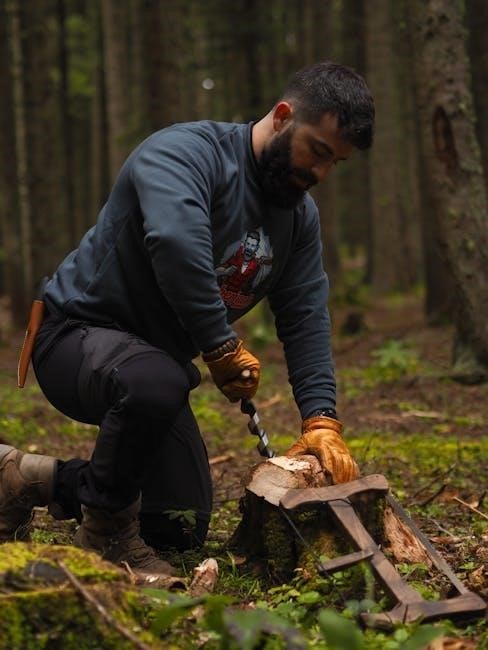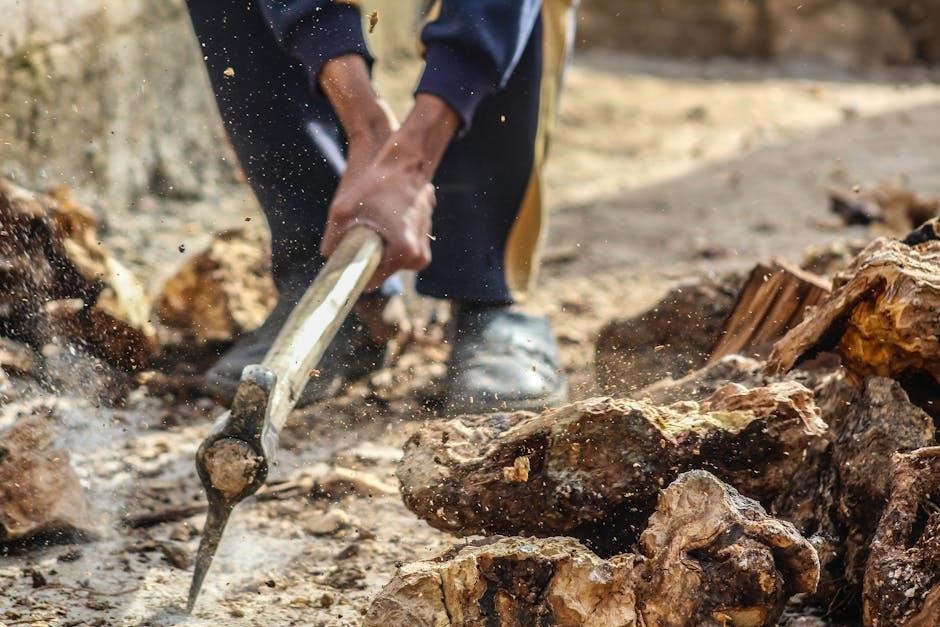Safety Precautions and Warnings
Always read and understand the manual before operating the Huskee 22-ton log splitter. Ensure proper assembly and follow all safety guidelines to avoid serious injury or death.
1.1 Essential Safety Information
Always read and understand this manual before operating the Huskee 22-ton log splitter. Wear protective gear‚ including gloves and safety glasses. Ensure loose clothing or jewelry is tied back. Keep children and bystanders away from the operating area. Never operate the log splitter if unsure about its safe use. Follow all safety decals and warnings provided on the machine. Properly assemble the unit as instructed to avoid malfunctions. Use the log splitter only for its intended purpose—splitting wood logs lengthwise with the grain. Failure to adhere to these guidelines may result in serious injury or death.
1.2 Safety Symbols and Their Meanings
The Huskee 22-ton log splitter features several safety symbols to alert operators of potential hazards. The warning triangle indicates a risk of injury and requires immediate attention. The prohibited actions symbol (a circle with a line through it) identifies actions not to be performed‚ such as operating without guards. The caution symbol (exclamation mark) signals important safety information. The eye protection symbol reminds users to wear safety glasses. The general warning symbol alerts to potential hazards like moving parts. Understanding these symbols is crucial for safe operation and preventing accidents. Always refer to the manual for detailed explanations.
1.3 Emergency Procedures
In case of an emergency‚ immediately shut off the engine and disconnect the power source. If a person is injured‚ provide first aid and seek medical help. For machine malfunctions‚ stop operation and contact professional support. Never attempt repairs while the log splitter is in use. Always remove the spark plug wire before servicing. Keep emergency contact numbers handy‚ such as the customer service hotline (1-800-525-8322). Store the manual nearby for quick reference. Ensure all safety protocols are followed to prevent accidents and ensure safe operation of the Huskee 22-ton log splitter. Regular maintenance can help prevent emergencies.

Product Specifications
The Huskee 22-ton log splitter‚ models 1032822 and 1032830‚ features a 190cc Briggs & Stratton engine‚ designed for efficient wood splitting with hydraulic functionality.
2.1 Model Numbers and Variants
The Huskee 22-ton log splitter is available in two models: 1032822 and 1032830. Both models share similar specifications‚ including a 22-ton splitting capacity and a 190cc Briggs & Stratton engine. Model 1032822 is configured for vertical operation‚ while model 1032830 offers both vertical and horizontal functionality. These variants cater to different user preferences and operational needs. Always refer to the specific model number for accurate specifications and maintenance requirements. Ensure compatibility with optional accessories‚ such as the SpeeCo 4-Way Splitting Wedge‚ designed for enhanced performance.
2.2 Engine Details and Power Output
The Huskee 22-ton log splitter is powered by a 190cc Briggs & Stratton engine‚ model number 39052900. This engine delivers reliable performance and consistent power output for splitting logs. The EX series engine features improved fuel efficiency and durability. The engine has a 0.75L oil capacity and requires SAE 30 oil for optimal operation. Always check the oil level before starting the engine to ensure proper lubrication and prevent damage. The engine’s power output is specifically designed to handle the 22-ton splitting capacity‚ making it suitable for both vertical and horizontal configurations. Regular maintenance is essential for prolonged engine life.
2.3 Hydraulic and Oil Requirements
The Huskee 22-ton log splitter requires 5 gallons of hydraulic oil to ensure optimal performance. Use a high-quality hydraulic oil with a viscosity rating suitable for the operating temperature. The hydraulic system operates at a maximum pressure of 2‚200 PSI. Regularly check the oil level in the hydraulic reservoir‚ located near the power unit‚ and refill as needed using the recommended oil type. Replace the hydraulic oil every 500 hours of operation to maintain efficiency. Additionally‚ the engine requires SAE 30 oil‚ with a capacity of 0.75 liters. Always refer to the manual for specific oil specifications and maintenance schedules. Proper lubrication is crucial for extending the life of both the engine and hydraulic components.
Carefully unpack and inventory all parts and hardware. Follow the step-by-step guide for assembling the log splitter‚ ensuring all bolts are securely tightened. Refer to the manual for specific torque specifications and assembly diagrams. Ensure the unit is placed on a level surface for proper operation. If unsure‚ contact customer support for assistance. Always wear protective gear during assembly to prevent injury. Before starting assembly‚ ensure all components are included and undamaged. Gather essential tools like wrenches‚ screwdrivers‚ and sockets. Locate a clean‚ flat workspace to prevent losing parts. Follow the manual’s diagrams to attach the hydraulic cylinder‚ splitting wedge‚ and beam. Tighten all bolts securely‚ referencing torque specifications. Connect hydraulic hoses carefully to avoid leaks. Ensure the log splitter is on a level surface to guarantee stability. If unsure about any step‚ consult the manual or contact customer support. Proper assembly is crucial for safe and efficient operation. Always double-check connections before use. To assemble the Huskee 22-ton log splitter‚ you’ll need an adjustable wrench‚ socket set‚ screwdrivers‚ and pliers. Ensure all bolts‚ nuts‚ and hydraulic hoses are included in the package. Refer to the parts list in the manual to verify completeness. Hydraulic fluid and engine oil must be added before operation. Use a torque wrench for securing critical connections‚ following specifications in the manual. Keep rags and a drain pan handy for fluid handling. Double-check that all components‚ such as the splitting wedge and beam‚ are correctly labeled and undamaged. If any parts are missing‚ contact customer support before proceeding. Always organize parts to avoid misplacement during assembly. Begin by attaching the hydraulic cylinder to the main frame using the provided bolts. Next‚ install the splitting wedge‚ ensuring it is securely fastened; Attach the beam to the hydraulic cylinder‚ aligning it properly. Connect the hydraulic hoses to the cylinder and control valve‚ tightening all connections firmly. Install the engine and hydraulic fluid reservoir‚ following the manual’s specifications; Fill the reservoir with the recommended hydraulic fluid and engine oil. Connect the spark plug wire and ensure all safety decals are in place. Double-check all connections for leaks and test the splitter at low pressure before full operation. Refer to the manual for detailed diagrams and torque specifications. If unsure‚ contact customer support for assistance. Always follow safety precautions during assembly. Read the manual thoroughly before operating. Ensure the log splitter is on a level surface. Start the engine‚ engage the hydraulic system‚ and slowly advance the splitting wedge. Always maintain control of the joystick and keep hands away from moving parts. Split logs along the grain‚ never against it. Avoid overloading the machine. Stop immediately if unusual noises occur and consult the manual for troubleshooting. Always turn off the engine before performing any maintenance or repairs. Before starting‚ ensure the log splitter is on a level surface and all safety precautions are followed. Remove the spark plug wire to prevent accidental start-up during assembly or maintenance. Check the hydraulic oil and engine oil levels‚ ensuring they are at the recommended levels. Once ready‚ reconnect the spark plug wire and follow the engine’s starting procedure. For vertical mode‚ ensure the splitter is securely locked in position. In horizontal mode‚ confirm the log is properly aligned. Start the engine‚ allow it to warm up briefly‚ then slowly engage the hydraulic control to begin splitting logs. Always maintain control of the joystick and monitor the machine’s operation closely. Always position the log splitter on a stable‚ level surface. Ensure logs are properly aligned with the splitting wedge. Place logs firmly against the splitter’s table or cradle‚ avoiding loose clothing or long hair that could get caught. Use both hands to guide the log‚ maintaining a safe distance from the wedge. Split logs along the grain for easier division. Avoid splitting overly large or knotted logs‚ as they may cause damage. Keep bystanders‚ especially children‚ at a safe distance. Never overload the machine beyond its 22-ton capacity. Stop immediately if unusual noises or vibrations occur. Always follow the manufacturer’s guidelines for optimal performance and safety. When using the Huskee 22-ton log splitter‚ ensure logs are cut to appropriate lengths and free of debris. Hardwoods like oak and maple may require more force‚ while softwoods like pine split more easily. Avoid splitting logs with knots or metal debris‚ as they can damage the wedge or hydraulic system. Moisture content matters; excessively wet wood may not split cleanly‚ while overly dry wood can shatter. Always align the log grain correctly for efficient splitting. For particularly stubborn logs‚ consider using a log splitter wedge or consulting the manual for specific recommendations. Proper wood preparation ensures safe and effective operation. Regular checks of hydraulic fluid‚ engine oil‚ and wedge condition are essential. Lubricate moving parts periodically and consult the manual for troubleshooting specific issues regularly. Regular maintenance is crucial for optimal performance. Check hydraulic fluid levels daily‚ ensuring they meet the recommended specifications. Inspect the engine oil level before each use and top it off as needed. The log splitter’s wedge and cutting surfaces should be free from debris and damage. Lubricate all moving parts periodically to prevent wear. Always refer to the manual for specific guidelines on fluid types and capacities. Regularly inspect hoses and connections for signs of wear or leaks. Address any issues promptly to maintain efficiency and safety. Common issues with the Huskee 22-ton log splitter include low hydraulic fluid levels‚ engine difficulty starting‚ and wedge damage. If the splitter operates slowly‚ check hydraulic fluid levels and top off as needed. For engine issues‚ ensure the spark plug wire is securely connected and refer to the Briggs & Stratton manual. Inspect the wedge for damage; replace it if worn or chipped. Regular lubrication of moving parts can prevent mechanical failures. Addressing these issues promptly ensures smooth operation and extends the lifespan of the log splitter. Always follow the manufacturer’s guidelines for repairs and maintenance. Contact professional support if you encounter issues beyond your ability to resolve. For complex mechanical or hydraulic problems‚ or if the log splitter sustains significant damage‚ seek expert assistance. If the engine fails to start after troubleshooting‚ or if there are persistent hydraulic leaks‚ call 1-800-525-8322 for guidance. Provide your model number (e.g.‚ 1032822 or 1032830) and a detailed description of the issue. Professional support is also recommended for warranty-related inquiries or if repairs require specialized tools or knowledge. Always prioritize safety and efficiency by consulting experts for major repairs.
Assembly and Installation
3.1 Initial Assembly Requirements
3.2 Tools and Parts Needed
3.3 Step-by-Step Assembly Guide
Operating Instructions

4.1 Starting the Log Splitter
4.2 Proper Techniques for Splitting Logs
4.3 Handling Different Types of Wood

Maintenance and Troubleshooting
5.1 Regular Maintenance Checks
5.2 Common Issues and Solutions
5.3 When to Contact Professional Support


